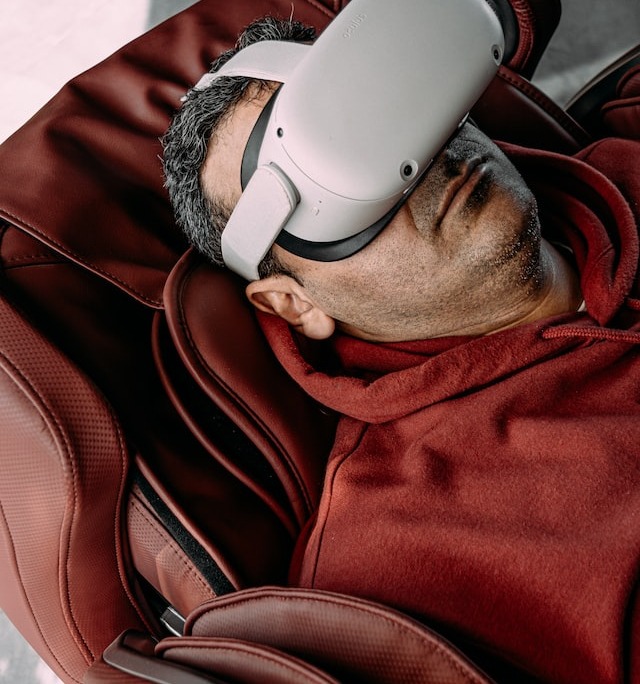The Evolution of Virtual Reality: Not Just a Modern Marvel
Most people think of VR as a new technology, although it has been around for many decades. Flight simulators in the 1950s gave pilots a taste of what we call virtual reality today – replicating real-world conditions for training without the risks of actual flights.
The real breakthrough came in 1968 when computer scientist Ivan Sutherland and his student Bob Sproull created “The Sword of Damocles,” the first head-mounted VR display. Crude and cumbersome by today’s standards, this pioneering device introduced head-tracking and stereoscopic images – fundamental concepts still used in today’s VR.
Remember those bulky VR gaming pods in arcades during the ’80s and ’90s? Systems like Virtuality introduced many of us to immersive gaming, despite their limitations in graphics and responsiveness. But it wasn’t until computing power caught up with creative vision that VR truly began to flourish.
Under the Hood: How Modern VR Creates Digital Worlds
VR systems now are engineering marvels that bring together a series of technologies to try to trick our brains into thinking digital worlds are reality:
The Headset Experience
New VR headsets like the Oculus Quest 3, HTC Vive Pro, and PlayStation VR2 have high-resolution screens that show slightly different images to each eye. This stereoscopic technique replicates how our eyes naturally perceive depth, with the illusion of three-dimensional space the outcome.
Movement That Matters
What if you look up at a virtual sky or turn to face a virtual friend? Motion tracking systems – internal cameras, external sensors, and gyroscopes – track these movements in real time. The VR world changes instantly, maintaining the illusion that you are really there in a different world.
Sounds From All Sides
Close your eyes in a good VR experience and you can still tell where things are happening. That’s spatial audio at work – sound designed to be emanating from specific directions, just like in the real world. When you’re in VR and you hear footsteps behind you, your brain processes that information exactly as it would in real life.
The Touch of Digital Reality
New haptic suits and controllers offer another level of immersion through touch. Fine vibrations and resistance can simulate weight and texture when you lift an object in VR, though we’re still far from perfect tactile feedback. These technologies are also advancing at a very rapid rate.
Creating Realistic Worlds
Some of the most impressive VR experiences use photogrammetry – creating 3D models from photographs of actual places. Through this process, developers can recreate everything from ancient ruins to modern cities with amazing accuracy, transporting you to places you might never visit in life.

Beyond Gaming: VR’s Impact in the Real World
Revolutionizing Education
VR converts abstract concepts to tangible experiences. Biology students can walk through the human circulatory system. History classes can witness the signing of the Declaration of Independence. Geography classes can travel to the Amazon rainforest or the summit of Mount Everest.
In poorly resourced schools, VR democratizes learning experiences. A class in rural America can “visit” the Louvre or coral reefs without expensive field trips.
Training for High-Stakes Professions
Medical Training Without Risk
Residents can perform complex surgeries hundreds of times in VR before ever touching a patient. They can make mistakes, learn from them, and hone their craft in a space without consequences.
Emergency Response Preparation
Firefighters, paramedics, and disaster response teams use VR to simulate crisis scenarios that would be impossible or dangerous to recreate in real training exercises. They can practice decision-making under pressure without risking anyone’s safety.
Healthcare Breakthroughs
Confronting Phobias and Anxiety
For someone with a fear of heights, progressive exposure therapy in VR allows him or her to stand on higher and higher virtual ledges while being physically safe. This has yielded remarkable success in the treatment of phobias, PTSD, and anxiety disorders.
Rediscovering Movement
Rehabilitation patients struggle with repetitive exercises. VR converts these types of exercises into interactive games, which are more engaging and can potentially accelerate recovery. Patients focus on the virtual task rather than the physical difficulty, perform better, and tend to have better outcomes.
Revolutionizing Remote Work and Collaboration
More Than Just Meetings
Architects can walk into the designs of buildings with clients before they are constructed. Engineering teams can examine 3D prototypes together from across the world. Artists can collaboratively work on three-dimensional paintings in virtual studios together.
Rapid Prototyping
Car manufacturers use VR to try out designs without actually producing models for each iteration. It saves enormous amounts of time and resources and allows for more creative experimentation.
The Road Ahead: VR’s Expanding Horizons
Increasingly Lifelike Experiences
As processing power grows and developers refine their craft, the gap between virtual and physical reality continues to narrow. Future VR may engage all senses so convincingly that distinguishing between virtual and physical experiences becomes genuinely challenging.
VR for Everyone
Early VR setups required expensive computers and complicated setup processes. Standalone headsets like the Quest 3 are bringing high-quality VR to more people than ever. As prices continue to fall and ease-of-use improves, VR will become even more mainstream.
Blending Realities
The lines between virtual reality and augmented reality are also blurring into mixed reality, where digital and physical elements combine interactively. The technology promises to transform even how we shop and how we design our living spaces.
Virtual Communities
As VR becomes more social, we’re seeing the emergence of virtual communities where people meet, interact, and share experiences regardless of location. These spaces will someday be as central to our social lives as physical meeting places.
The Virtual Reality Revolution Continues
From its experimental beginnings to the sophisticated systems of today, virtual reality has made great strides over the years. Driven by high-end computing, photorealistic rendering, and multisensory feedback, modern VR enables experiences that until recently were the domain of science fiction.
As the technology becomes increasingly mainstream and applications extend far beyond entertainment, VR will continue to transform the way we learn, work, heal, and interact with each other. The journey from those early, crude flight simulators to the immersive worlds of today is just the beginning – virtual reality’s finest chapters are still to be written.

